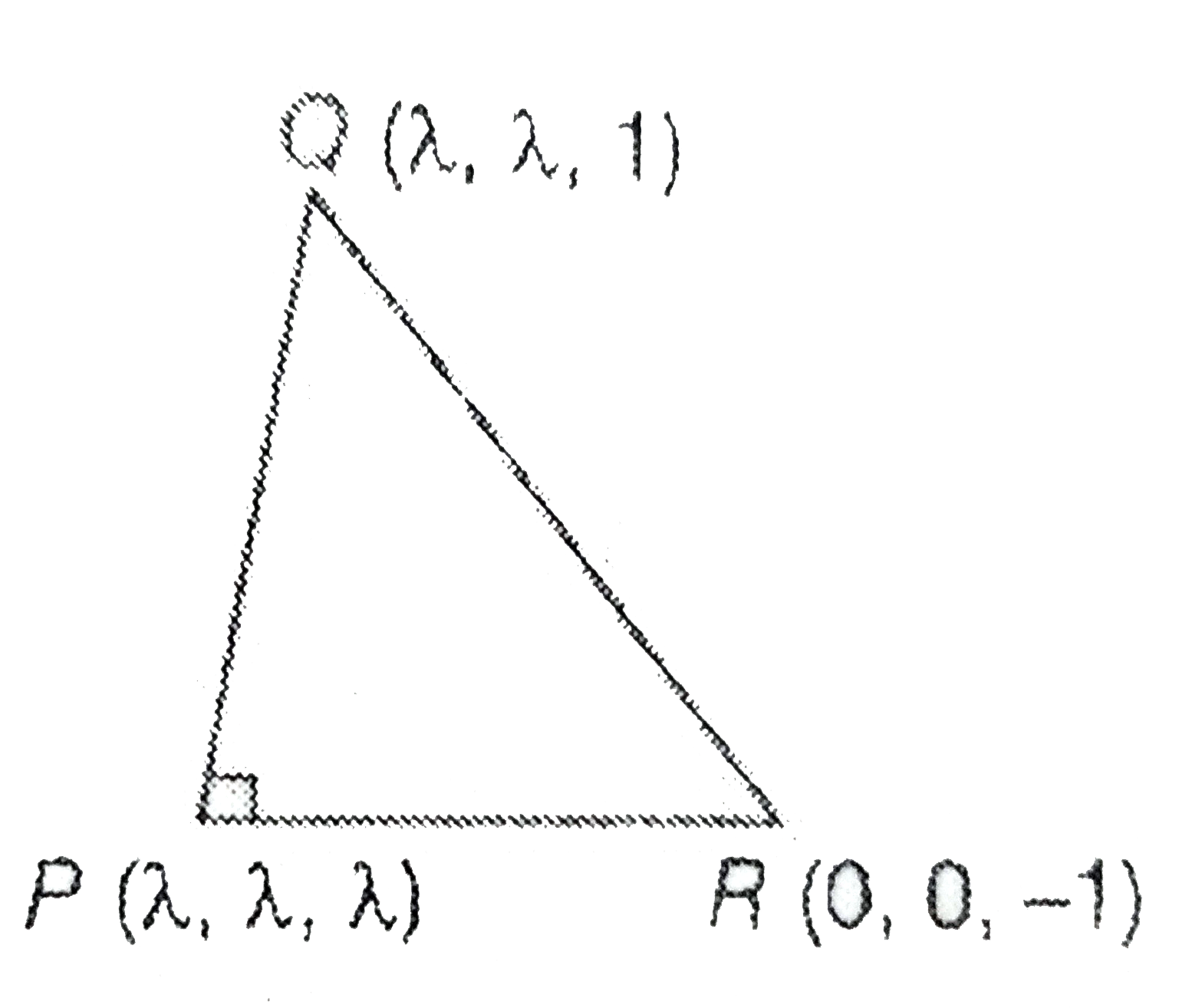From a point P(λ,λ,λ), perpendicular PQ and PR are drawn respectively on the lines y=x,z=1 and y=−x,z=−1.If P is such that ∠QPR is a right angle, then the possible value(s) of λ is/(are)
√2
1
-1
−√2
The correct Answer is:C
(i) Direction ratios of a line joining two points (x1,y1,z1) and (x2,y2,z2) are x2−x1,y2−y1,z2−z1.
(ii) If the two lines with direction ratios a1,b1c1,a2,b2,c2 are perpendicular, thena1a2+b1b2+c1c2=0
Line L1 is given by y=x,z=1 can be expressed
L1:x1=y1=z−10=α [say]
⇒ x=α,y=α,z=1
Let the corrdinates of Q on L1 be (α,α,1).
Line L2 given by y=−x,z=−1 can be expressed as
L2:x1=y−1=z+10=β [say]
⇒ x=β,y=−β,z=−1
Let the coordinates of R on L2 be (β,−β,−1).
Direction ratios of PQ are λ−α,λ−α,λ−1.
Now, PQ⊥L1

∴ 1(λ−α)+1.(λ−α)+0.(λ−1)=0⇒λ=α
Hence, Q(λ,λ,1)
Direction retios of PR are λ−β,λ+β,λ+1.
Now, PR⊥L2
∴ 1(λ−β)+(−1)(λ+β)+0(λ+1)=0
λ−β−λ=0
⇒ β=0
Hence, R(0,0,−1)
Now, as ∠QPR=90∘
[as a1a2+b1b2+c1c2=0, if two lines with DR's a1,b1,c1,a2,b2,c2 are perpendicular]
∴ (λ−λ)(λ−0)+(λ−λ)(λ−0)+(λ−1)(λ+1)=0
⇒ (λ−1)(λ+1)=0
⇒ λ=1
or λ=−1
λ=1, rejected as P and Q are different points.
⇒ λ=−1
Topper's Solved these Questions
- BOOK - IIT JEE PREVIOUS YEARCHAPTER - 3D GeometryEXERCISE - Equation of Plane Objective Question I (Only one correct option)49videos
3D Geometry
- BOOK - IIT JEE PREVIOUS YEARCHAPTER - 3D GeometryEXERCISE - Equation of Plane Objective Question II (One or more than pne correct option)5videos
3D Geometry
- BOOK - IIT JEE PREVIOUS YEARCHAPTER - 3D GeometryEXERCISE - Straight Line in Space and Shortest Distance Objective Question I (Only one correct option)6videos
3D Geometry
- BOOK - IIT JEE PREVIOUS YEARCHAPTER - PROPERTIES OF TRIANGLESEXERCISE - CIRCUMCIRCLE, INCIRCLE, ESCRIBED CIRCLE, ORTHOCENTRE,INCENTRE AND CIRCUMCENTRE20videos
PROPERTIES OF TRIANGLES
- BOOK - IIT JEE PREVIOUS YEARCHAPTER - APPLICATION OF DERIVATIVES EXERCISE - MAXIMA AND MINIMA ( INTEGER ANSWER TYPE QUESTIONS)8videos
APPLICATION OF DERIVATIVES
Similar Questions
From a point P(λ,λ,λ), perpendicular PQ and PR are drawn respectively on the lines y=x,z=1 and y=−x,z=−1.If P is such that ∠QPR is a right angle, then the possible value(s) of λ is/(are)
View SolutionIf the direction ratios of a line are 1+λ,2−λ,4 and if it makes an angle of 60∘ with the y- axis, then the sum of the values of λ is
View Solution
Knowledge Check
- Question 1 - Select One
If the system of equations
λx+2y+3z=x
λy−2z=y
y+λz=4z
have a non zero solution, then sum of all possible values of λ isA2B−5C6D8 - Question 2 - Select One
If the angle θ between the line x+11=y−12=z−22 and the plane 2x−y+√λz+4=0 is such that sinθ=13. The value of λ is
A−43B34C−35D53 - Question 3 - Select One
If the lines x−11=y−31=z−2λ and x−1λ=y−32=z−41 intersect at a point, then the value of λ2+4 is equal to
A8B10C13D5
A chord PQ is a normal to the y2=4ax at P and subtendsa right angle at the verte SQ=λSP, where S is the focus, then the value of λ is
View SolutionLet two points be A(1,-1) and B(0,2) . If a point P(x',y') be such that the area of ΔPAB=5sq.unit and it lies on the line 3x+y−4λ=0 then value of λ is
View SolutionIf the line passing through the points (4,3)and(2,λ) is perpendicular to the line y=2x+3, then λ is equal to
View SolutionLet λ be an interger. If the shortest distance between the lines x−λ=2y−1=−2z and x=y+2λ=z−λ is √72√2, then the value of |λ| is _______ .
View SolutionA system of equations λx+y+z=1,x+λy+z=λ,x+y+λz=λ2 have no solution then value of λ is
View Solution

